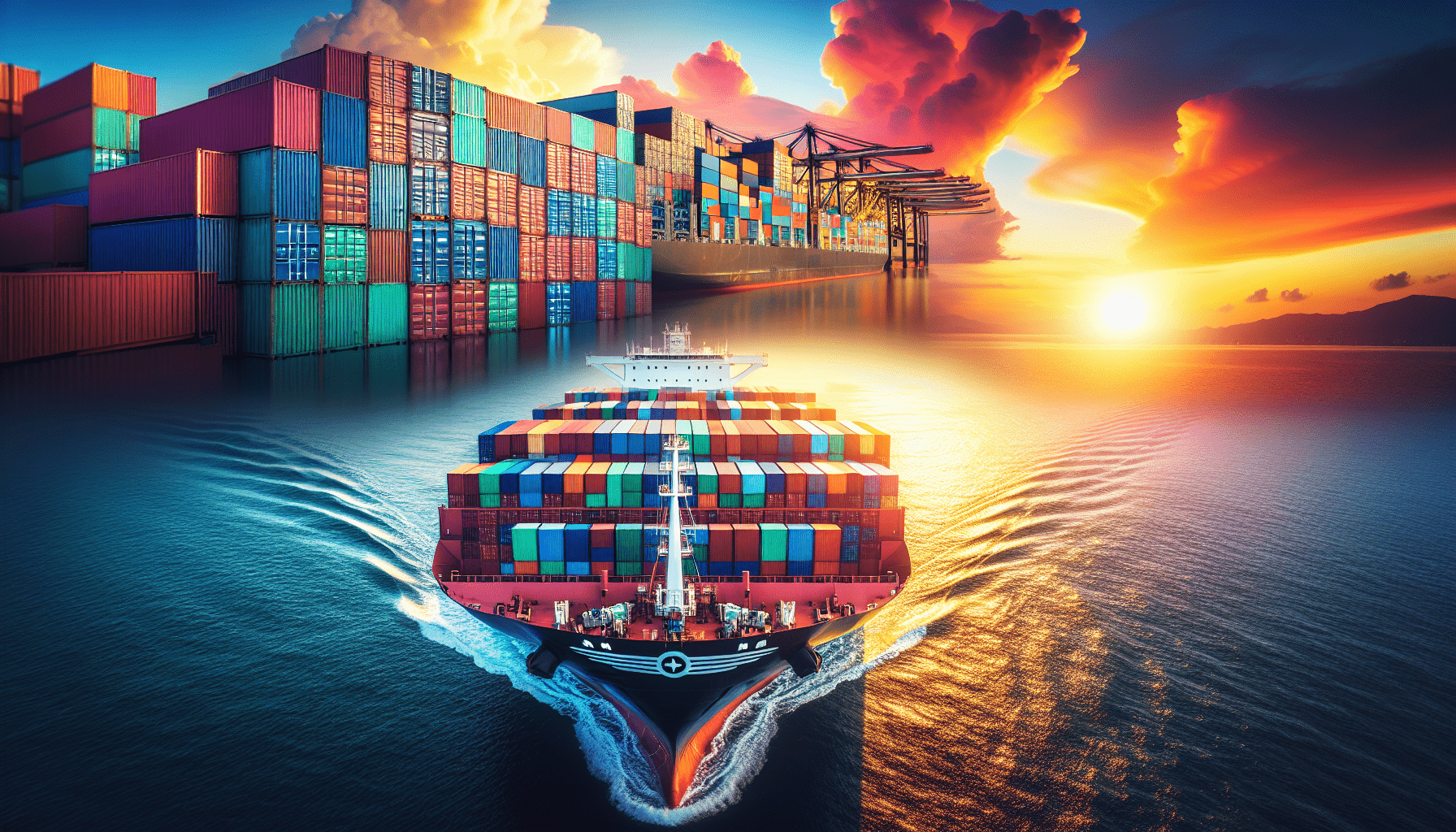Have you ever wondered how much it would cost to ship a container? Whether you’re a business owner expanding your operations or an individual in the process of relocating, understanding the average cost of shipping a container can help you plan and budget effectively. In this article, we will explore the factors that influence container shipping costs and provide you with a clear idea of what to expect when it comes to pricing. So, sit back, relax, and let’s delve into the world of container shipping costs together!

Factors Affecting Container Shipping Costs
Distance
The distance between the origin and destination plays a significant role in determining container shipping costs. The longer the distance, the higher the costs are likely to be. This is because shipping companies need to allocate more resources, including fuel and labor, to transport the container across a greater distance. Consequently, if you are shipping a container that needs to travel a considerable distance, you can expect the costs to be higher compared to shorter distances.
Container Size
Container size is another crucial factor that affects shipping costs. Shipping companies offer containers of various sizes, such as 20-foot and 40-foot containers. Larger containers have more space to accommodate a higher volume of cargo, which can lead to increased shipping costs. On the other hand, smaller containers are generally more cost-effective for shipping smaller consignments. Therefore, it’s essential to determine the appropriate container size based on your cargo volume to optimize costs.
Type of Cargo
The type of cargo being shipped also impacts container shipping costs. Some cargoes, such as hazardous materials or perishable goods, require special handling and additional safety measures. These requirements can increase the overall shipping costs. Similarly, oversized or overweight cargo may require specialized equipment or permits, leading to higher shipping expenses. Before shipping your cargo, it’s important to consider any specific requirements that might affect the overall costs.
Shipping Route
The shipping route chosen can significantly influence container shipping costs. Certain routes may be more popular or efficient, resulting in lower costs due to economies of scale. For example, shipping routes with a high volume of traffic between major ports are likely to offer more competitive pricing. On the other hand, less frequently used or remote routes may have higher costs due to limited availability or additional transportation requirements. When planning your shipment, it’s worth considering different shipping routes and their associated costs.
Shipping Method
The shipping method you choose also affects container shipping costs. There are various methods of shipping containers, such as full container load (FCL) and less than container load (LCL). FCL involves shipping a container exclusively for your cargo, while LCL combines multiple shipments in one container. FCL shipments may have higher initial costs but can be more cost-effective for larger volumes. LCL shipments, on the other hand, may be more suitable for smaller consignments but can incur additional costs for consolidation and deconsolidation. Understanding the pros and cons of different shipping methods is crucial in managing shipping costs effectively.
Average Cost of Shipping a Container
Cost per Mile
The average cost of shipping a container can be calculated based on the cost per mile. Shipping companies consider factors like fuel, maintenance, and labor costs when determining the cost per mile. While the specific cost per mile can vary depending on various factors, such as the shipping route and the type of cargo, it provides a useful metric for estimating shipping costs. By multiplying the total distance by the cost per mile, you can estimate the shipping expenses for a particular container shipment.
Cost per TEU
The cost per TEU (Twenty-foot Equivalent Unit) is another common method of calculating container shipping costs. A TEU represents the cargo capacity of a standard 20-foot container. Shipping companies often provide rates based on the number of TEUs required for a shipment. By multiplying the cost per TEU by the number of TEUs needed, you can calculate the shipping costs for your container. This approach allows for easy comparison between different shipments and carriers, helping you make informed decisions when it comes to cost optimization.
Cost per CBM
The cost per CBM (Cubic Meter) is particularly relevant when dealing with bulk or loose cargo. By considering the volume of the cargo rather than the number of containers, the cost per CBM provides a more accurate representation of shipping costs. This method takes into account the space utilized by the cargo, allowing for better cost optimization. Multiplying the cost per CBM by the total volume of the cargo will give you an estimate of the shipping costs. If you have a non-containerized cargo, such as machinery or vehicles, using the cost per CBM is essential for accurate cost calculations.
Average Total Cost
When calculating the average total cost of shipping a container, it’s important to consider all the factors mentioned above. This includes the distance, container size, type of cargo, shipping route, and shipping method. By taking into account these variables and using the appropriate cost calculation method, you can arrive at a reasonably accurate average total cost for your container shipment. Keep in mind that additional costs, such as customs duties, insurance, and handling charges, will need to be factored in to determine the final cost.
Additional Costs to Consider
Customs Duties and Taxes
When shipping internationally, customs duties and taxes are additional costs that need to be considered. These charges are imposed by the destination country’s customs authority and are based on the value or type of goods being imported. It’s important to research and understand the customs regulations and duty rates of the destination country to avoid any unexpected costs. Additionally, working with a customs broker or freight forwarder can help navigate the complexities of customs clearance and ensure compliance with all regulations.
Cargo Insurance
Cargo insurance is an essential cost to consider when shipping a container. While shipping companies often offer a basic level of liability coverage, it may not provide adequate protection for your cargo. Purchasing additional cargo insurance can safeguard your shipment against loss or damage during transit. The cost of insurance will depend on factors such as the value of the cargo, the shipping route, and the level of coverage desired. Investing in comprehensive cargo insurance is a wise decision to mitigate any potential financial losses.
Port Charges
Port charges are fees imposed by the ports for various services rendered during the shipping process. These charges can include terminal handling fees, pier usage fees, and port security fees. The amount of port charges can vary depending on the specific port and the services required. It’s important to factor in these charges when calculating overall shipping costs and to consider the efficiency and reliability of different ports in terms of handling your cargo.
Terminal Handling Charges
Terminal handling charges (THC) are fees levied by the terminals for handling and moving containers within the port. These charges cover activities such as loading and unloading containers, storage, and documentation processing. The amount of THC can vary depending on factors like the size of the container, the type of cargo, and the specific terminal. It’s crucial to be aware of these charges and consider them when evaluating overall shipping costs. Researching different terminals and their associated THC can help you make informed decisions to optimize costs.
Fuel Surcharge
Fuel surcharges are additional fees imposed by shipping companies to account for fluctuations in fuel prices. Since fuel costs can be volatile, especially in the shipping industry, surcharges are used to pass on the fuel-related expenses to the customers. The amount of the surcharge varies based on factors such as the fuel price index and the distance being covered. It’s important to consider fuel surcharges when calculating shipping costs, as they can contribute significantly to the total expenses. Keeping track of fuel price trends and understanding how surcharges are calculated can help you manage and budget for these additional costs effectively.
Ways to Save on Container Shipping Costs
Negotiating Rates with Freight Forwarders
One effective way to save on container shipping costs is by negotiating rates with freight forwarders. Freight forwarders are intermediaries between shippers and carriers, and they can leverage their relationships and volume discounts to secure more favorable rates. By comparing quotes from different freight forwarders and negotiating based on the specific requirements of your shipment, you can potentially achieve cost savings. It’s important to provide accurate details about your cargo, shipping timeline, and any special requirements to facilitate effective rate negotiations.
Consolidation or Full Load Container
Opting for consolidation or a full load container can help save on shipping costs, depending on the characteristics of your shipment. Consolidation involves combining multiple smaller shipments into a single container, sharing the costs with other shippers. This approach is suitable for smaller consignments that don’t require an entire container. Conversely, if you have a large shipment that can fill an entire container, choosing a full load container can be more cost-effective than shipping multiple less-than-container load (LCL) shipments. Assessing the volume and frequency of your shipments can help determine the most cost-efficient approach.
Choosing the Right Shipping Method
Choosing the right shipping method can contribute to significant cost savings. As mentioned earlier, full container load (FCL) and less-than-container load (LCL) are two common methods of shipping containers. If you have a substantial volume of cargo, opting for FCL can be more cost-effective in the long run. However, if you have smaller shipments or irregular volumes, LCL may be a more economical choice. Additionally, considering the transit time and reliability of different shipping methods can help avoid costly delays or expedited services.
Optimizing Packaging and Loading
Optimizing packaging and loading can have a direct impact on container shipping costs. Ensuring efficient use of space within the container will enable you to maximize cargo volume and minimize wasted space. Properly securing and organizing the cargo can also contribute to reduced risks of damage during transit, leading to potential cost savings on claims or insurance premiums. Collaborating with your shipping company or freight forwarder to assess packing and loading strategies can help identify opportunities for cost optimization.
Using a Freight Rate Calculator
Utilizing a freight rate calculator can be a valuable tool in saving on container shipping costs. These calculators consider various factors such as distance, container size, and shipping method to provide estimates of shipping costs. By inputting your specific cargo details and comparing rates from multiple carriers, you can make informed decisions based on cost optimization. It’s important to note that the accuracy of these calculators may vary, so using them as a reference point and obtaining quotes from freight forwarders is still advisable.

Average Cost of Shipping Container by Route
Asia to North America
The average cost of shipping a container from Asia to North America can vary depending on several factors. This shipping route is one of the busiest in the world and offers competitive rates due to the high volume of trade. The average cost per TEU for this route can range from $1,500 to $2,500. However, it’s important to consider that rates can fluctuate based on market conditions, fuel prices, and carrier-specific factors. Additionally, the specific ports of origin and destination within Asia and North America will also influence the overall shipping costs.
Europe to South America
The average cost of shipping a container from Europe to South America is influenced by factors such as distance, trade volume, and carrier choices. This route involves crossing the Atlantic Ocean and can be more expensive compared to other shorter routes. The average cost per TEU for this route can range from $3,000 to $4,500. However, these rates can be subject to changes based on market dynamics and carrier-specific factors. Additionally, the specific ports within Europe and South America will also affect the overall shipping costs.
Oceania to Africa
Shipping containers from Oceania to Africa involves crossing the Indian Ocean and can have varying costs depending on the specific ports and carriers chosen. This route often requires transshipment at intermediate ports, which can add to the overall shipping costs. The average cost per TEU for this route can range from $2,500 to $3,500. However, it’s essential to obtain quotes from multiple carriers and consider the specific ports of origin and destination within Oceania and Africa for accurate cost estimation.
Comparison of Container Shipping Rates by Carriers
Maersk Line
Maersk Line is one of the largest container shipping companies globally and offers comprehensive services across various trade routes. Their rates can be competitive, particularly for high-volume cargo and popular routes. Maersk Line provides online tools and platforms that enable customers to obtain tailored quotes, track shipments, and manage documentation. It’s advisable to compare Maersk Line’s rates with other carriers to ensure you are getting the best value for your shipping requirements.
MSC
MSC (Mediterranean Shipping Company) is another major player in the container shipping industry, offering extensive coverage and a wide range of services. With a global network and a diverse fleet, MSC can provide competitive rates for various trade routes. Their focus on customer service and digitalization enables efficient shipment management and real-time tracking. When comparing rates, it’s worthwhile to consider MSC’s offerings along with other carriers to find the most cost-effective solution for your container shipping needs.
CMA CGM
CMA CGM is a leading shipping company with a strong presence in both container shipping and logistics services. They offer a comprehensive range of containerized shipping options and value-added services. CMA CGM’s focus on sustainability and customer-centric solutions make them a preferred choice for many shippers. It’s recommended to evaluate their rates alongside other carriers to determine the most suitable and cost-effective option for your specific shipping requirements.
Cosco Shipping
Cosco Shipping is a prominent shipping company known for its strong presence in the Asia-Pacific region and extensive international network. With a focus on providing reliable and efficient services, Cosco Shipping offers competitive rates for various trade routes. Their commitment to innovation and digitalization enhances shipment visibility and customer experience. Comparing Cosco Shipping’s rates with other carriers can help you identify cost-saving opportunities and make informed decisions.
Hapag-Lloyd
Hapag-Lloyd is a global shipping company with a solid reputation for quality services and customer satisfaction. With a diverse fleet and extensive coverage, Hapag-Lloyd offers competitive rates for container shipping across numerous trade routes. Their emphasis on sustainability and innovation aligns with the evolving needs of the industry. When comparing shipping rates, it’s beneficial to include Hapag-Lloyd in your evaluation to ensure you have considered all available options.
Potential Future Trends in Container Shipping Costs
Environmental Regulations
As the global focus on sustainability intensifies, environmental regulations are likely to impact container shipping costs. Stricter emissions standards, fuel regulations, and carbon pricing mechanisms can increase operational costs for shipping companies. Compliance with these regulations may require investments in more fuel-efficient vessels or alternative propulsion systems. While these advancements may reduce environmental impact, they can potentially lead to higher shipping costs. Shippers should be prepared for potential price adjustments as the industry adapts to evolving environmental regulations.
Infrastructure Development
Infrastructure development, particularly in ports and transportation networks, can influence container shipping costs. Enhancing capacity, efficiency, and connectivity through infrastructure investments can positively impact overall logistics costs. Upgraded port facilities, improved intermodal transportation, and streamlined customs processes can lead to cost savings. However, these infrastructure developments may involve temporary disruptions or increased fees during the construction and transition periods. It’s important to monitor infrastructure projects and collaborate with reliable partners to minimize any potential cost implications.
Digitalization in Logistics
The rapid advancement of digitalization in the logistics industry has the potential to transform container shipping costs. Digital solutions and platforms can optimize planning, routing, and cargo visibility, leading to improved efficiency and reduced costs. Real-time tracking, predictive analytics, and data sharing enable enhanced collaboration and informed decision-making. Additionally, digital marketplaces and freight exchanges can facilitate greater transparency and competitiveness in rates. Embracing digitalization and leveraging innovative technologies can help shippers mitigate potential cost increases and enhance supply chain performance.
Conclusion
Container shipping costs are influenced by various factors, including distance, container size, type of cargo, shipping route, and shipping method. Understanding these factors and their impact on costs is essential for effective cost management. Additionally, considering additional costs such as customs duties, insurance, port charges, terminal handling charges, and fuel surcharges is crucial to avoid any unforeseen expenses.
By exploring ways to save on container shipping costs, such as negotiating rates, optimizing packaging and loading, and using freight rate calculators, shippers can achieve cost savings. Furthermore, comparing shipping rates offered by different carriers, such as Maersk Line, MSC, CMA CGM, Cosco Shipping, and Hapag-Lloyd, allows for informed decision-making.
Potential future trends, including environmental regulations, infrastructure development, and digitalization, highlight the ever-evolving nature of container shipping costs. Shippers should stay informed and adapt to these trends to effectively manage costs and maximize efficiency in their container shipping operations.

I am James, the creator behind SeaBoxInnovations.com. Welcome to our premier online destination dedicated to the world of sea containers. Think Inside the Box is our tagline, and our website is your go-to source for exploring the endless potential of these versatile and adaptable containers. Whether you’re interested in purchasing, customizing, or learning about the latest trends in container architecture and design, we have you covered. Join us as we bridge the gap between traditional uses and cutting-edge applications, promoting sustainability and innovation in design and construction. Get ready to embark on your next big project with SeaBoxInnovations.com.

